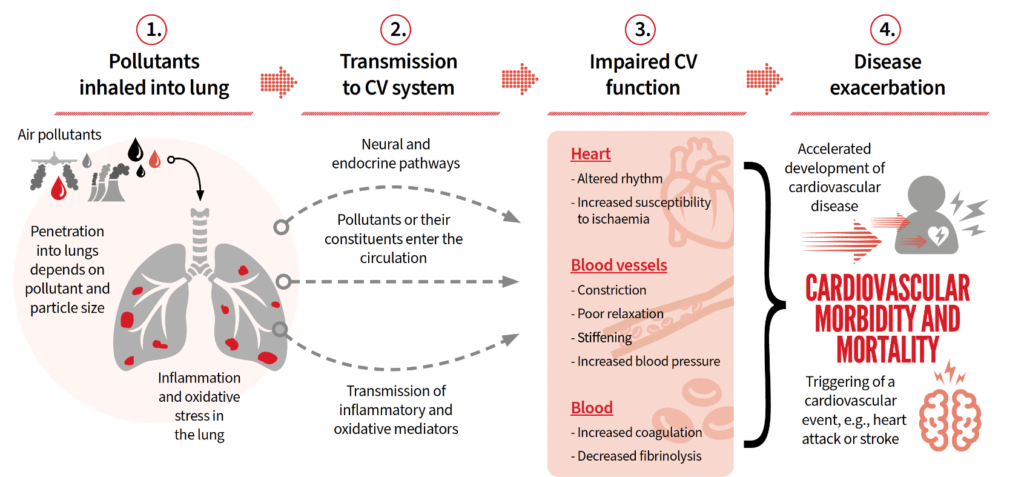Air pollution and cardiovascular disease are increasingly linked in recent health studies, highlighting a pressing global health crisis. According to the latest report from the World Heart Federation, outdoor air pollution alone is responsible for at least 1.9 million deaths annually from heart disease and just under a million from strokes.
This alarming statistic underscores the significant impact of air pollution on cardiovascular health, making it the greatest single environmental health risk today. As the number of deaths from cardiovascular conditions caused by air pollution continues to rise, there is an urgent need for comprehensive policy action to address this critical issue and protect public health.
Air pollution has emerged as the greatest single environmental health risk, significantly impacting cardiovascular health. According to a recently released World Heart Federation (WHF) report, at least 1.9 million people die every year from heart disease and just under a million from strokes due to outdoor air pollution alone. This startling revelation underscores the urgent need for comprehensive policy actions to mitigate this escalating health crisis.
Key Points:
- Over 2 billion people still rely on polluting fuels.
- Nearly 7 million deaths were linked to air pollution in 2019.
- Recommendations include adopting WHO air quality guidelines, improving air pollution monitoring, and increasing funding for research.

Rising Death Toll from Cardiovascular Diseases
The WHF report reveals that in 2019, approximately 4.2 million deaths were attributed to outdoor air pollution, with nearly 70% linked to cardiovascular diseases (CVDs). The number of deaths from cardiovascular disease caused by air pollution has been on the rise over the past decade and is projected to increase further. In some regions, deaths from air pollution and heart disease have surged by up to 27% over the past decade, emphasizing the severity of the issue.
Global Health Crisis
Air pollution is responsible for about 25% of all CVD deaths, equating to over 1.9 million preventable deaths annually from heart disease alone. This statistic highlights the critical need for governments worldwide to implement effective legislation aimed at reducing air pollution. The WHF report serves as a stark reminder of the profound impact of air pollution on global health, particularly cardiovascular health.
The rise in global air pollution levels has been directly associated with an increase in air pollution and heart disease, underscoring the urgent need for improved environmental regulations. Air pollution and cardiovascular disease are closely linked, with increasing evidence showing that long-term exposure to pollutants significantly heightens the risk of developing serious heart conditions.

Regional Disparities in Air Quality
Air quality levels have shown minimal improvement globally, with some areas experiencing pollution levels nearly ten times higher than WHO recommendations. Countries in Southeast Asia and the Eastern Mediterranean are particularly affected, with PM2.5 concentrations often exceeding safe limits. These regional disparities highlight the need for targeted interventions to improve air quality and protect heart disease.
Exposure to particulate matter air pollution and cardiovascular disease is particularly concerning, as fine particles in the air have been shown to exacerbate heart conditions.
Health Effects Beyond Cardiovascular Diseases
The harmful effects of prolonged exposure to high levels of air pollution extend beyond cardiovascular diseases. The WHF report indicates that air pollution exacerbates various health issues, including obesity and diabetes. This complicates the health landscape and calls for a multi-faceted approach to tackle air pollution.
Coordinated efforts across health, environment, and transportation sectors are essential to effectively address this issue. Researchers are increasingly focused on understanding how air pollution cardiovascular disease manifests, as evidence mounts about the detrimental effects of pollutants on heart health.

Policy Recommendations for Combating Air Pollution
To mitigate the health impacts of air pollution, the WHF advocates for comprehensive policies that promote cleaner transport, energy-efficient homes, and better waste management. Structural actions are necessary, but healthcare providers can also play a crucial role in mitigating the health impacts of air pollution through advocacy and education.
Indoor Air Pollution: An Overlooked Health Risk
While outdoor air pollution is a significant concern, indoor air pollution also poses a serious health risk. Sources of indoor air pollution include transport, industry, and wildfires. The cumulative impact of air pollution from various sources often widens gaps in healthcare for vulnerable populations, worsening health outcomes regardless of demographic factors.
The Situation in India: A Case Study
For a country like India, the high levels of air pollution, especially during the onset of winter, are extremely worrisome. A new study published in Lancet Planetary Health highlights that in 10 major cities in India—Delhi, Ahmedabad, Bengaluru, Chennai, Hyderabad, Kolkata, Mumbai, Pune, Shimla, and Varanasi—around 33,000 deaths every year are attributable to PM2.5 pollution levels that breach WHO guidelines.
The study recommends upgrading the national standard for fine particulate matter (PM2.5) and recalibrating the Graded Response Action Plan to focus on year-round action rather than just pollution extremes. Covering more cities for air pollution control is also crucial, as most cities in India do not meet WHO guidelines. The adverse impact will only worsen unless governments act proactively with stronger regulations and stringent measures.
Addressing air pollution heart disease is critical, as prolonged exposure to toxic air pollutants is a major risk factor for developing cardiovascular problems.”
Global Levels/Trends of Ambient Air Pollution
From 2010 to 2019, global levels of PM2.5 (fine particulate matter) remained largely stable, with an annual reduction of 1%. Europe recorded the largest decline, while Africa saw an increase. In 2019, no country had PM2.5 concentrations below the WHO recommended threshold.
Regional Trends:
- Europe: 2.1% annual reduction.
- Africa: 0.3% annual increase.
- Only 14% of countries experienced large declines in PM2.5 levels.
Ambient Air Pollution and Health
Ambient air pollution is a major risk factor for mortality and disability. It is linked to various cardiovascular conditions, including IHD, cerebrovascular disease, stroke, heart failure, and more. The mechanisms by which air pollution affects the cardiovascular system include endothelial dysfunction, oxidative stress, and inflammation.
Cardiovascular Mortality:
- Stroke deaths attributable to air pollution increased by 1% from 2010 to 2019.
- Europe saw a significant decline in stroke mortality rates, while Africa, South-East Asia, and Eastern Mediterranean regions recorded increases.

Household (Indoor) Air Pollution and CVDs
Household air pollution, primarily from cooking and heating with solid fuels, is a significant health risk, particularly in low- and middle-income countries (LMICs). It is linked to cardiovascular diseases and other health issues.
Key Facts:
- Government interventions can accelerate the adoption of clean cooking solutions.
- Successful programs in countries like China, India, and Indonesia demonstrate the potential for large-scale impact.
Air Pollution and Climate Change
Climate change and air pollution are interlinked. Major sources of air pollution, such as fossil fuel combustion, also drive climate change. Environmental events caused by climate change, in turn, exacerbate air pollution, creating a vicious cycle.
Impacts:
- Increase in the risk of cardiovascular disease due to air pollution and Extreme temperatures.
- Climate change mitigation efforts can also reduce air pollution.

Air Quality Guidelines and Policies
National and local governments play a crucial role in reducing air pollution through policy implementation. The 2021 WHO Global Air Quality Guidelines provide recommendations for air pollutant levels and interim targets.
Policy Areas:
- Agriculture: Reducing ammonia emissions from agricultural practices.
- Vehicle Standards: Legislation to ensure emission testing and maintenance of vehicle filters.
- Clean Domestic Fuels: Moving from solid fuels to cleaner options like LPG and solar panels.
- Urban Planning: Developing “20-minute neighbourhoods” to reduce reliance on private vehicles.
Key Recommendations for Air Pollution and Cardiovascular Disease
To address the air pollution crisis, all countries and stakeholders must urgently work together. The healthcare sector should take a leading role in reducing emissions as part of sustainability strategies.
Recommendations:
- Adopt WHO air quality and heart disease guidelines.
- Support a global fossil fuel non-proliferation treaty.
- Improve air pollution monitoring and modelling.
- Increase funding for multidisciplinary research and technological innovations.
- Conduct additional studies on the cardiovascular effects of air pollution.
Conclusion: The Urgent Need for Policy Action on air pollution and cardiovascular disease
The WHF report emphasizes that the number of deaths from cardiovascular conditions caused by air pollution is set to increase further unless immediate action is taken. Air pollution is ubiquitous, sparing no one, and driving deaths from ‘air pollution cardiovascular disease’, which remains the leading cause of mortality worldwide. The cumulative impact of air pollution from multiple sources exacerbates health disparities and worsens outcomes for vulnerable populations.
The relationship between cardiovascular disease and air pollution is becoming clearer, with studies showing that contaminated air significantly increases the risk of heart attacks and strokes.
To address this pressing issue, governments must implement stronger regulations and stringent measures to reduce air pollution. Efficient implementation of these measures is crucial to mitigate the adverse health impacts of air pollution and prevent millions of avoidable deaths each year. The WHF report serves as a critical reminder of the urgent need for policy action to protect global health and combat the rising tide of “air pollution and cardiovascular disease“
What is the main cause of air pollution?
Major sources include fossil fuel combustion, industrial emissions, agricultural practices, and household activities like cooking and heating with solid fuels.
How does air pollution affect cardiovascular health?
Air pollution causes endothelial dysfunction, oxidative stress, and inflammation, leading to various cardiovascular diseases such as IHD, stroke, and heart failure.
What are some effective strategies to reduce air pollution?
Strategies include adopting WHO air quality guidelines, improving air pollution monitoring, increasing funding for research, and implementing policies to reduce emissions from agriculture, vehicles, and households.
What can individuals do to reduce exposure to air pollution?
Individuals can reduce exposure by using cleaner cooking fuels, avoiding outdoor activities during high pollution periods, and advocating for policies that reduce air pollution.
How does air pollution cause cerebrovascular disease?
Air pollution contributes to cerebrovascular disease, such as strokes, through several mechanisms:
Inflammation: Pollutants like particulate matter (PM2.5) and nitrogen dioxide can cause systemic inflammation, affecting blood vessels in the brain.
Oxidative Stress: Airborne toxins generate reactive oxygen species, leading to oxidative stress that damages brain cells and blood vessels.
Blood Pressure: Exposure to pollutants can increase blood pressure, a significant risk factor for strokes.
Atherosclerosis: Pollutants accelerate the process of atherosclerosis, the buildup of fatty deposits in blood vessels, which can lead to stroke if occurring in cerebral arteries.
DheerajSonwane is a dedicated writer with expertise in air purification technologies. He focuses on providing well-researched content to help readers improve indoor air quality in homes and businesses. As the lead writer at AirPurifierMaster.com, Dheeraj offers practical advice his insightful reviews guide individuals in choosing the best air purifiers for their needs.

